IoC容器基础
IoC容器基础
Spring框架最核心的其实它的IoC容器,这是我们开启Spring学习的第一站。
IoC理论介绍
在我们之前的图书管理系统Web应用程序中,我们发现,整个程序其实是依靠各个部分相互协作,共同完成一个操作,比如要展示借阅信息列表,那么首先需要使用Servlet进行请求和响应的数据处理,然后请求的数据全部交给对应的Service(业务层)来处理,当Service发现要从数据库中获取数据时,再向对应的Mapper发起请求。
它们之间就像连接在一起的齿轮,谁也离不开谁:
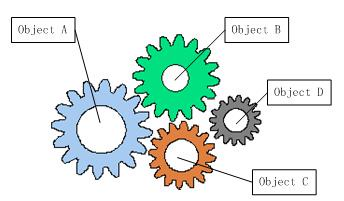
就像一个团队,每个人的分工都很明确,流水线上的一套操作必须环环相扣,这是一种高度耦合的体系。
虽然这样的体系逻辑非常清晰,整个流程也能够让人快速了解,但是这样存在一个很严重的问题,我们现在的时代实际上是一个软件项目高速迭代的时代,我们发现很多App三天两头隔三差五地就更新,而且是什么功能当下最火,就马不停蹄地进行跟进开发,因此,就很容易出现,之前写好的代码,实现的功能,需要全部推翻,改成新的功能,那么我们就不得不去修改某些流水线上的模块,但是这样一修改,会直接导致整个流水线的引用关系大面积更新。
比如下面的情况:
class A{
private List<B> list;
public B test(B b){
return null;
}
}
class C{
public C(B b){}
}
class B{ }
可以看到,A和C在大量地直接使用B,但是某一天,这个B的实现已经过时了,此时来了个把功能实现的更好的D,我们需要用这个新的类来完成业务了:
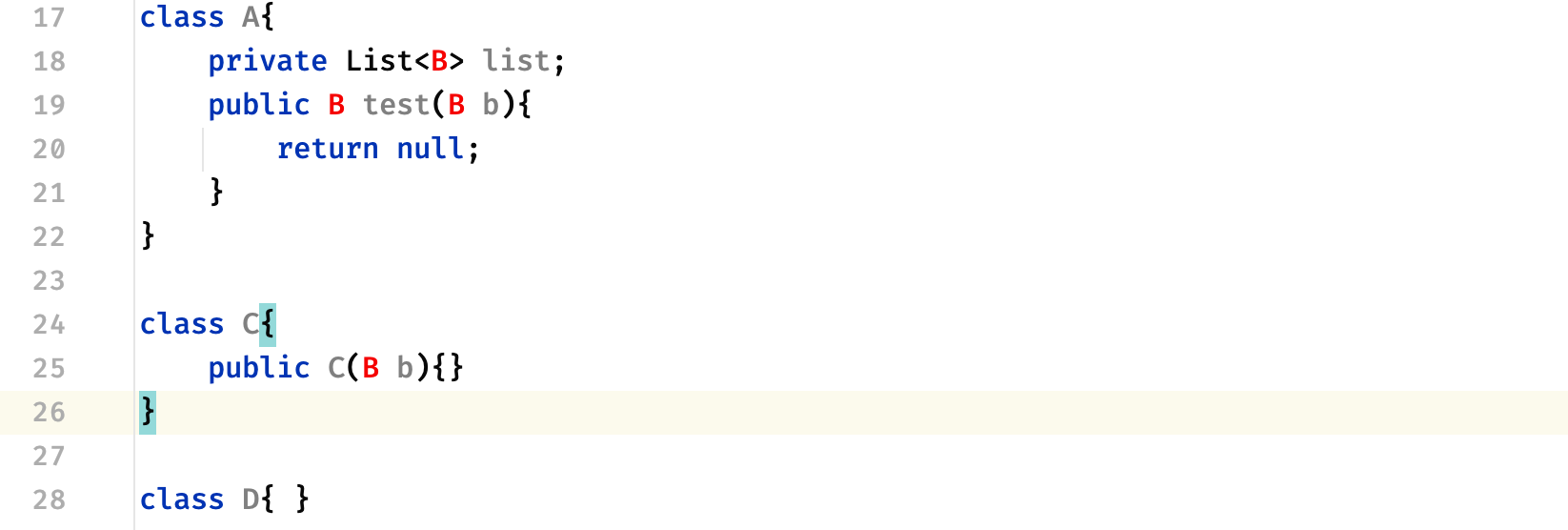
可以看到,因为类之间的关联性太强了,会开始大面积报错,所有之前用了B的类,得挨个进行修改,全都改成D,这简直是灾难啊!
包括我们之前JavaWeb阶段编写的实战项目,如果我们不想用某个Service实现类了,我想使用其他的实现类用不同的逻辑做这些功能,那么这个时候,我们只能每个类都去挨个进行修改,当项目特别庞大时,光是改个类名导致的连带修改就够你改一天了。
因此,高耦合度带来的缺点是很明显的,也是现代软件开发中很致命的问题。如果要改善这种情况,我们只能将各个模块进行解耦,让各个模块之间的依赖性不再那么地强。也就是说,Service的实现类,不再由我们决定,而是让程序自己决定,所有的实现类对象,全部交给程序来管理,所有对象之间的关系,也由程序来动态决定,这样就引入了IoC理论。
IOC是Inversion of Control的缩写,翻译为:“控制反转”,把复杂系统分解成相互合作的对象,这些对象类通过封装以后,内部实现对外部是透明的,从而降低了解决问题的复杂度,而且可以灵活地被重用和扩展。
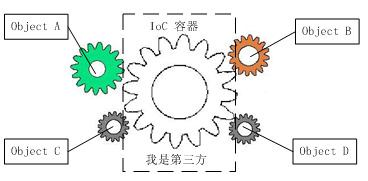
我们可以将对象交给IoC容器进行管理,比如当我们需要一个接口的实现时,由它根据配置文件来决定到底给我们哪一个实现类,这样,我们就可以不用再关心我们要去使用哪一个实现类了,我们只需要关心,给到我的一定是一个可以正常使用的实现类,能用就完事了,反正接口定义了啥,我只管调,这样,我们就可以放心地让一个人去写视图层的代码,一个人去写业务层的代码,开发效率那是高的一匹啊。
还是之前的代码,但是有了IoC容器加持之后:
public static void main(String[] args) {
A a = new A();
a.test(IoC.getBean(Service.class)); //瞎编的一个容器类,但是是那个意思
//比如现在在IoC容器中管理的Service的实现是B,那么我们从里面拿到的Service实现就是B
}
class A{
private List<Service> list; //一律使用Service,具体实现由IoC容器提供
public Service test(Service b){
return null;
}
}
interface Service{ } //使用Service做一个顶层抽象
class B implements Service{} //B依然是具体实现类,并交给IoC容器管理
当具体实现类发生修改时,我们同样只需要将新的实现类交给IoC容器管理,这样我们无需修改之前的任何代码:
这样,即使我们的底层实现类发生了修改,也不会导致与其相关联的类出现错误,而进行大面积修改,通过定义抽象+容器管理的形式,我们就可以将原有的强关联解除。
高内聚,低耦合,是现代软件的开发的设计目标,而Spring框架就给我们提供了这样的一个IoC容器进行对象的的管理,一个由Spring IoC容器实例化、组装和管理的对象,我们称其为Bean。
第一个Spring项目
首先一定要明确,使用Spring首要目的是为了使得软件项目进行解耦,而不是为了去简化代码!通过它,就可以更好的对我们的Bean进行管理,这一部分我们来体验一下Spring的基本使用。
Spring并不是一个独立的框架,它实际上包含了很多的模块:
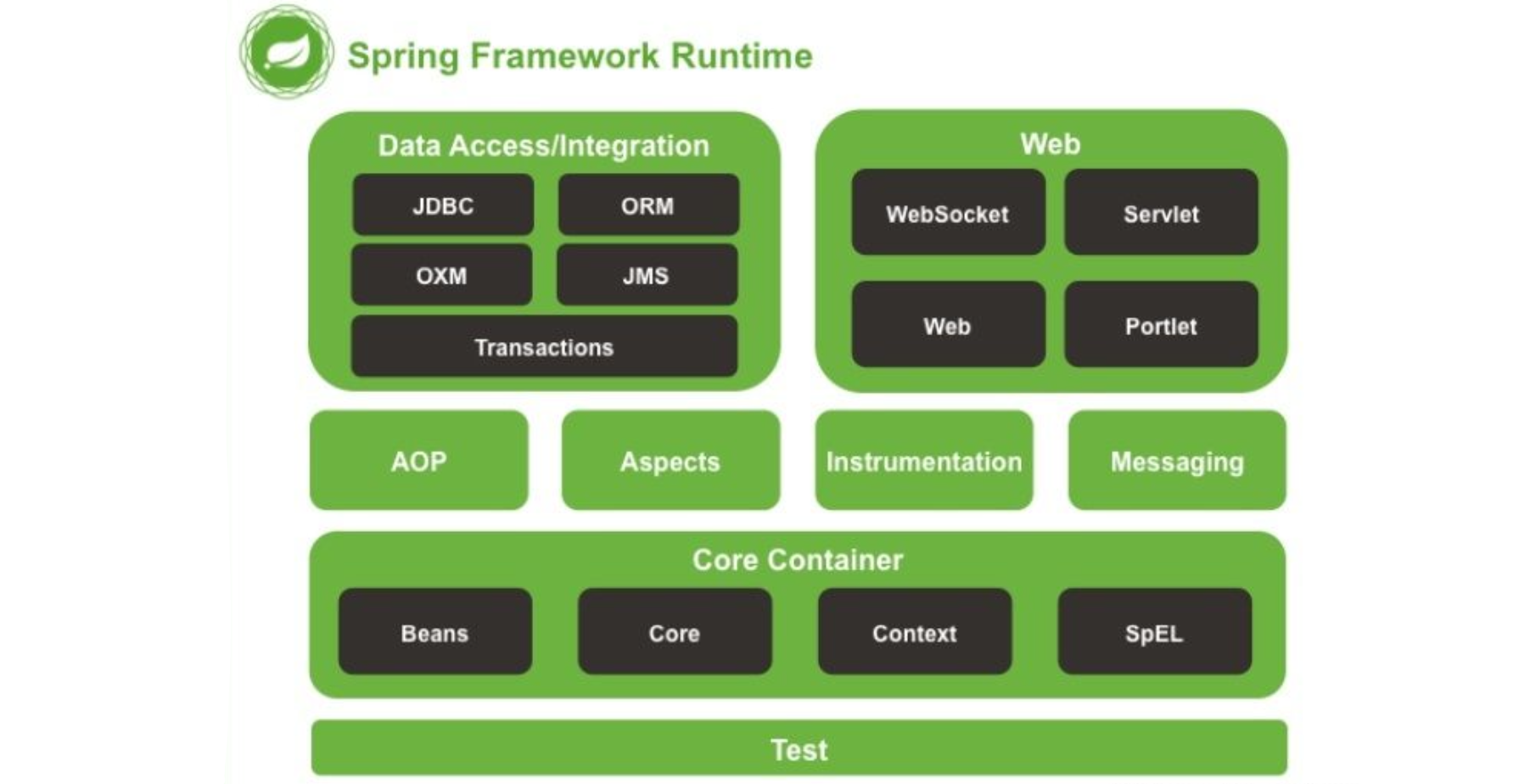
而我们首先要去学习的就是Core Container,也就是核心容器模块,只有了解了Spring的核心技术,我们才能真正认识这个框架为我们带来的便捷之处。

Spring是一个非入侵式的框架,就像一个工具库一样,它可以很简单地加入到我们已有的项目中,因此,我们只需要直接导入其依赖就可以使用了,Spring核心框架的Maven依赖坐标:
<dependency>
<groupId>org.springframework</groupId>
<artifactId>spring-context</artifactId>
<version>6.0.10</version>
</dependency>
注意: 与旧版教程不同的是,Spring 6要求你使用的Java版本为17及以上,包括后面我们在学习SpringMvc时,要求Tomcat版本必须为10以上。这个依赖中包含了如下依赖:
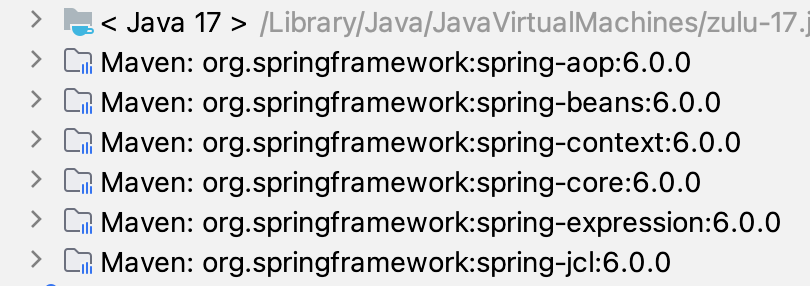
这里出现的都是Spring核心相关的内容,如Beans、Core、Context、SpEL以及非常关键的AOP框架.

这里我们就来尝试编写一个最简的Spring项目,我们在前面已经讲过了,Spring会给我们提供IoC容器用于管理Bean,但是我们得先为这个容器编写一个配置文件,我们可以通过配置文件告诉容器需要管理哪些Bean以及Bean的属性、依赖关系等等。
首先我们需要在resource中创建一个Spring配置文件(在resource中创建的文件,会在编译时被一起放到类路径下),命名为test.xml,直接右键点击即可创建:
<?xml version="1.0" encoding="UTF-8"?>
<beans xmlns="http://www.springframework.org/schema/beans"
xmlns:xsi="http://www.w3.org/2001/XMLSchema-instance"
xsi:schemaLocation="http://www.springframework.org/schema/beans
https://www.springframework.org/schema/beans/spring-beans.xsd">
</beans>

此时IDEA会提示我们没有为此文件配置应用程序上下文,这里我们只需要指定成当前项目就行了,当然配置这个只是为了代码提示和依赖关系快速查看,如果不进行配置也不会影响什么,程序依然可以正常运行:

这里我们直接按照默认配置点确定就行了:

Spring为我们提供了一个IoC容器,用于去存放我们需要使用的对象,我们可以将对象交给IoC容器进行管理,当我们需要使用对象时,就可以向IoC容器去索要,并由它来决定给我们哪一个对象。而我们如果需要使用Spring为我们提供的IoC容器,那么就需要创建一个应用程序上下文,它代表的就是IoC容器,它会负责实例化、配置和组装Bean:
public static void main(String[] args) {
//ApplicationContext是应用程序上下文的顶层接口,它有很多种实现,这里我们先介绍第一种
//因为这里使用的是XML配置文件,所以说我们就使用 ClassPathXmlApplicationContext 这个实现类
ApplicationContext context = new ClassPathXmlApplicationContext("test.xml"); //这里写上刚刚的名字
}

比如现在我们要让IoC容器帮助我们管理一个Student对象(Bean),当我们需要这个对象时再申请,那么就需要这样,首先先将Student类定义出来:
package com.test.bean;
public class Student {
public void hello(){
System.out.println("Hello World!");
}
}
既然现在要让别人帮忙管理对象,那么就不能再由我们自己去new这个对象了,而是编写对应的配置,我们打开刚刚创建的test.xml文件进行编辑,添加:
这里我们就在配置文件中编写好了对应Bean的信息,之后容器就会根据这里的配置进行处理了。

现在,这个对象不需要我们再去创建了,而是由IoC容器自动进行创建并提供,我们可以直接从上下文中获取到它为我们创建的对象:
public static void main(String[] args) {
ApplicationContext context = new ClassPathXmlApplicationContext("test.xml");
Student student = (Student) context.getBean("student"); //使用getBean方法来获取对应的对象(Bean)
student.hello();
}

实际上,这里得到的Student对象是由Spring通过反射机制帮助我们创建的,初学者会非常疑惑,为什么要这样来创建对象,我们直接new一个它不香吗?为什么要交给IoC容器管理呢?在后面的学习中,我们再慢慢进行体会。



Bean注册与配置
前面我们通过一个简单例子体验了一下如何使用Spring来管理我们的对象,并向IoC容器索要被管理的对象。这节课我们就来详细了解一下如何向Spring注册Bean以及Bean的相关配置。
实际上我们的配置文件可以有很多个,并且这些配置文件是可以相互导入的:
但是为了简单起见,我们还是从单配置文件开始讲起,首先我们需要知道如何配置Bean并注册。
要配置一个Bean,只需要添加:
但是这样写的话,Spring无法得知我们要配置的Bean到底是哪一个类,所以说我们还得指定对应的类才可以:

可以看到类的旁边出现了Bean的图标,表示我们的Bean已经注册成功了,这样,我们就可以根据类型向容器索要Bean实例对象了:
public static void main(String[] args) {
ApplicationContext context = new ClassPathXmlApplicationContext("test.xml");
//getBean有多种形式,其中第一种就是根据类型获取对应的Bean
//容器中只要注册了对应类的Bean或是对应类型子类的Bean,都可以获取到
Student student = context.getBean(Student.class);
student.hello();
}

不过在有些时候,Bean的获取可能会出现歧义,我们可以来分别注册两个子类的Bean:
但是此时我们在获取Bean时却是索要的它们的父类:
运行时得到如下报错:

这里出现了一个Bean定义不唯一异常,很明显,因为我们需要的类型是Student,但是此时有两个Bean定义都满足这个类型,它们都是Student的子类,此时IoC容器不知道给我们返回哪一个Bean,所以就只能抛出异常了。

因此,如果我们需要一个Bean并且使用类型进行获取,那么必须要指明类型并且不能出现歧义:

那要是两个Bean的类型都是一样的呢?
这种情况下,就无法使用Class来进行区分了,除了为Bean指定对应类型之外,我们也可以为Bean指定一个名称用于区分:
<bean name="art" class="com.test.bean.ArtStudent"/>
<bean name="sport" class="com.test.bean.SportStudent"/>
name属性就是为这个Bean设定一个独一无二的名称(id属性也可以,跟name功能相同,但是会检查命名是否规范,否则会显示黄标),不同的Bean名字不能相同,否则报错:
这样,这两个Bean我们就可以区分出来了:

虽然目前这两Bean定义都是一模一样的,也没什么区别,但是这确实是两个不同的Bean,只是类型一样而已,之后我们还可以为这两个Bean分别设置不同的其他属性。
我们可以给Bean起名字,也可以起别名,就行我们除了有一个名字之外,可能在家里还有自己的小名:
这样,我们使用别名也是可以拿到对应的Bean的:


那么现在又有新的问题了,IoC容器创建的Bean是只有一个还是每次索要的时候都会给我们一个新的对象?我们现在在主方法中连续获取两次Bean对象:
Student student1 = context.getBean(Student.class);
Student student2 = context.getBean(Student.class);
System.out.println(student1 == student2); //默认为单例模式,对象始终为同一个
我们发现,最后得到的结果为true,那么说明每次从IoC容器获取到的对象,始终都是同一个,默认情况下,通过IoC容器进行管理的Bean都是单例模式的,这个对象只会被创建一次。

如果我们希望每次拿到的对象都是一个新的,我们也可以将其作用域进行修改:

这里一共有两种作用域,第一种是singleton,默认情况下就是这一种,当然还有prototype,表示为原型模式(为了方便叫多例模式也行)这种模式每次得到的对象都是一个新的:
Student student1 = context.getBean(Student.class); //原型模式下,对象不再始终是同一个了
Student student2 = context.getBean(Student.class);
System.out.println(student1 == student2);
实际上,当Bean的作用域为单例模式时,那么它会在一开始(容器加载配置时)就被创建,我们之后拿到的都是这个对象。而处于原型模式下,只有在获取时才会被创建,也就是说,单例模式下,Bean会被IoC容器存储,只要容器没有被销毁,那么此对象将一直存在,而原型模式才是相当于在要用的时候直接new了一个对象,并不会被保存。

当然,如果我们希望单例模式下的Bean不用再一开始就加载,而是一样等到需要时再加载(加载后依然会被容器存储,之后一直使用这个对象了,不会再创建新的)我们也可以开启懒加载:
开启懒加载后,只有在真正第一次使用时才会创建对象。



因为单例模式下Bean是由IoC容器加载,但是加载顺序我们并不清楚,如果我们需要维护Bean的加载顺序(比如某个Bean必须要在另一个Bean之前创建)那么我们可以使用depends-on来设定前置加载Bean,这样被依赖的Bean一定会在之前加载,比如Teacher应该在Student之前加载:
<bean name="teacher" class="com.test.bean.Teacher"/>
<bean name="student" class="com.test.bean.Student" depends-on="teacher"/>
这样就可以保证Bean的加载顺序了。
依赖注入
依赖注入(Dependency Injection, DI)是一种设计模式,也是Spring框架的核心概念之一。现在我们已经了解了如何注册和使用一个Bean,但是这样还远远不够,还记得我们一开始说的,消除类之间的强关联吗?比如现在有一个教师接口:
具体的实现有两个:
public class ArtTeacher implements Teacher{
@Override
public void teach() {
System.out.println("我是美术老师,我教你画画!");
}
}
public class ProgramTeacher implements Teacher{
@Override
public void teach() {
System.out.println("我是编程老师,我教你学Golang!");
}
}
我们的学生一开始有一个老师教他,比如美术老师:
public class Student {
private Teacher teacher = new ArtTeacher();
//在以前,如果我们需要制定哪个老师教我们,直接new创建对应的对象就可以了
public void study(){
teacher.teach();
}
}
但是我们发现,如果美术老师不教了,现在来了一个其他的老师教学生,那么就需要去修改Student类的定义:
可以想象一下,如果现在冒出来各种各样的类都需要这样去用Teacher,那么一旦Teacher的实现发生变化,会导致我们挨个对之前用到Teacher的类进行修改,这就很难受了。
而有了依赖注入之后,Student中的Teacher成员变量,可以由IoC容器来选择一个合适的Teacher对象进行赋值,也就是说,IoC容器在创建对象时,需要将我们预先给定的属性注入到对象中,非常简单,我们可以使用property标签来实现,我们将bean标签展开:
<bean name="teacher" class="com.test.bean.ProgramTeacher"/>
<bean name="student" class="com.test.bean.Student">
<property name="teacher" ref="teacher"/>
</bean>
同时我们还需要修改一下Student类,依赖注入要求对应的属性必须有一个set方法:
public class Student {
private Teacher teacher;
//要使用依赖注入,我们必须提供一个set方法(无论成员变量的访问权限是什么)命名规则依然是驼峰命名法
public void setTeacher(Teacher teacher) {
this.teacher = teacher;
}
...

使用property来指定需要注入的值或是一个Bean,这里我们选择ProgramTeacher,那么在使用时,Student类中的得到的就是这个Bean的对象了:


可以看到,现在我们的Java代码中,没有出现任何的具体实现类信息(ArtTeacher、ProgramTeacher都没出现)取而代之的是那一堆xml配置,这样,就算我们切换老师的实现为另一个类,也不用去调整代码,只需要变动一下Bean的类型就可以:
<!-- 只需要修改这里的class即可,现在改为ArtTeacher -->
<bean name="teacher" class="com.test.bean.ArtTeacher"/>
<bean name="student" class="com.test.bean.Student">
<property name="teacher" ref="teacher"/>
</bean>
这样,这个Bean的class就变成了新的类型,并且我们不需要再去调整其他位置的代码,再次启动程序:


通过依赖注入,是不是开始逐渐感受到Spring为我们带来的便利了?当然,依赖注入并不一定要注入其他的Bean,也可以是一个简单的值:
直接使用value可以直接传入一个具体值。
实际上,在很多情况下,类中的某些参数是在构造方法中就已经完成的初始化,而不是创建之后,比如:
public class Student {
private final Teacher teacher; //构造方法中完成,所以说是一个final变量
public Student(Teacher teacher){ //Teacher属性是在构造方法中完成的初始化
this.teacher = teacher;
}
...
我们前面说了,Bean实际上是由IoC容器进行创建的,但是现在我们修改了默认的无参构造,可以看到配置文件里面报错了:


很明显,是因为我们修改了构造方法,IoC容器默认只会调用无参构造,所以,我们需要指明一个可以用的构造方法,我们展开bean标签,添加一个constructor-arg标签:
<bean name="teacher" class="com.test.bean.ArtTeacher"/>
<bean name="student" class="com.test.bean.Student">
<constructor-arg name="teacher" ref="teacher"/>
</bean>
这里的constructor-arg就是构造方法的一个参数,这个参数可以写很多个,会自动匹配符合里面参数数量的构造方法,这里匹配的就是我们刚刚编写的需要一个参数的构造方法。


通过这种方式,我们也能实现依赖注入,只不过现在我们将依赖注入的时机提前到了对象构造时。
那要是出现这种情况呢?现在我们的Student类中是这样定义的:
public class Student {
private final String name;
public Student(String name){
System.out.println("我是一号构造方法");
this.name = name;
}
public Student(int age){
System.out.println("我是二号构造方法");
this.name = String.valueOf(age);
}
}
此时我们希望使用的是二号构造方法,那么怎么才能指定呢?有2种方式,我们可以给标签添加类型:
也可以指定为对应的参数名称:
反正只要能够保证我们指定的参数匹配到目标构造方法即可。

如果在使用Spring框架的过程中出现如下警告:
12月 17, 2022 3:26:26 下午 org.springframework.core.LocalVariableTableParameterNameDiscoverer inspectClass 警告: Using deprecated '-debug' fallback for parameter name resolution. Compile the affected code with '-parameters' instead or avoid its introspection: XXXX这是因为LocalVariableTableParameterNameDiscoverer在Spring 6.0.1版本已经被标记为过时,并且即将移除,请在Maven配置文件中为编译插件添加
-parameters编译参数:<build> <pluginManagement> <plugins> <plugin> <artifactId>maven-compiler-plugin</artifactId> <version>3.10.1</version> <configuration> <compilerArgs> <arg>-parameters</arg> </compilerArgs> </configuration> </plugin> </plugins> </pluginManagement> </build>没有此问题请无视这部分。
现在我们的类中出现了一个比较特殊的类型,它是一个集合类型:
public class Student {
private List<String> list;
public void setList(List<String> list) {
this.list = list;
}
}
对于这种集合类型,有着特殊的支持:
<bean name="student" class="com.test.bean.Student">
<!-- 对于集合类型,我们可以直接使用标签编辑集合的默认值 -->
<property name="list">
<list>
<value>AAA</value>
<value>BBB</value>
<value>CCC</value>
</list>
</property>
</bean>

不仅仅是List,Map、Set这类常用集合类包括数组在内,都是支持这样编写的,比如Map类型,我们也可以使用entry来注入:
<bean name="student" class="com.test.bean.Student">
<property name="map">
<map>
<entry key="语文" value="100.0"/>
<entry key="数学" value="80.0"/>
<entry key="英语" value="92.5"/>
</map>
</property>
</bean>
至此,我们就已经完成了两种依赖注入的学习:
- Setter依赖注入:通过成员属性对应的set方法完成注入。
- 构造方法依赖注入:通过构造方法完成注入。

自动装配
在之前,如果我们需要使用依赖注入的话,我们需要对property参数进行配置:
<bean name="student" class="com.test.bean.Student">
<property name="teacher" ref="teacher"/>
</bean>
但是有些时候为了方便,我们也可以开启自动装配。自动装配就是让IoC容器自己去寻找需要填入的值,我们只需要将set方法提供好就可以了,这里需要添加autowire属性:

autowire属性有两个值普通,一个是byName,还有一个是byType,顾名思义,一个是根据类型去寻找合适的Bean自动装配,还有一个是根据名字去找,这样我们就不需要显式指定property了。

此时set方法旁边会出现一个自动装配图标,效果和上面是一样的。



对于使用构造方法完成的依赖注入,也支持自动装配,我们只需要将autowire修改为:
这样,我们只需要提供一个对应参数的构造方法就可以了(这种情况默认也是byType寻找的):

这样同样可以完成自动注入:


自动化的东西虽然省事,但是太过机械,有些时候,自动装配可能会遇到一些问题,比如出现了下面的情况:


此时,由于autowire的规则为byType,存在两个候选Bean,但是我们其实希望ProgramTeacher这个Bean在任何情况下都不参与到自动装配中,此时我们就可以将它的自动装配候选关闭:
<bean name="teacher" class="com.test.bean.ArtTeacher"/>
<bean name="teacher2" class="com.test.bean.ProgramTeacher" autowire-candidate="false"/>
<bean name="student" class="com.test.bean.Student" autowire="byType"/>
当autowire-candidate设定false时,这个Bean将不再作为自动装配的候选Bean,此时自动装配候选就只剩下一个唯一的Bean了,报错消失,程序可以正常运行。

除了这种方式,我们也可以设定primary属性,表示这个Bean作为主要的Bean,当出现歧义时,也会优先选择:
<bean name="teacher" class="com.test.bean.ArtTeacher" primary="true"/>
<bean name="teacher2" class="com.test.bean.ProgramTeacher"/>
<bean name="student" class="com.test.bean.Student" autowire="byType"/>
这样写程序依然可以正常运行,并且选择的也是ArtTeacher(就是不知道为什么IDEA会上红标,BUG?)

生命周期与继承
除了修改构造方法,我们也可以为Bean指定初始化方法和销毁方法,以便在对象创建和被销毁时执行一些其他的任务:
public void init(){
System.out.println("我是对象初始化时要做的事情!");
}
public void destroy(){
System.out.println("我是对象销毁时要做的事情!");
}
我们可以通过init-method和destroy-method来指定:
那么什么时候是初始化,什么时候又是销毁呢?
//当容器创建时,默认情况下Bean都是单例的,那么都会在一开始就加载好,对象构造完成后,会执行init-method
ClassPathXmlApplicationContext context = new ClassPathXmlApplicationContext("test.xml");
//我们可以调用close方法关闭容器,此时容器内存放的Bean也会被一起销毁,会执行destroy-method
context.close();
所以说,最后的结果为:


注意,如果Bean不是单例模式,而是采用的原型模式,那么就只会在获取时才创建,并调用init-method,而对应的销毁方法不会被调用(因此,对于原型模式下的Bean,Spring无法顾及其完整生命周期,而在单例模式下,Spring能够从Bean对象的创建一直管理到对象的销毁)官方文档原文如下:
In contrast to the other scopes, Spring does not manage the complete lifecycle of a prototype bean. The container instantiates, configures, and otherwise assembles a prototype object and hands it to the client, with no further record of that prototype instance. Thus, although initialization lifecycle callback methods are called on all objects regardless of scope, in the case of prototypes, configured destruction lifecycle callbacks are not called. The client code must clean up prototype-scoped objects and release expensive resources that the prototype beans hold. To get the Spring container to release resources held by prototype-scoped beans, try using a custom bean post-processor, which holds a reference to beans that need to be cleaned up.
Bean之间也是具备继承关系的,只不过这里的继承并不是类的继承,而是属性的继承,比如:
public class SportStudent {
private String name;
public void setName(String name) {
this.name = name;
}
}
public class ArtStudent {
private String name;
public void setName(String name) {
this.name = name;
}
}
此时,我们先将ArtStudent注册一个Bean:
<bean name="artStudent" class="com.test.bean.ArtStudent">
<property name="name" value="小明"/>
</bean>
这里我们会注入一个name的初始值,此时我们创建了一个SportStudent的Bean,我们希望这个Bean的属性跟刚刚创建的Bean属性是一样的,那么我们可以写一个一模一样的:

但是如果属性太多的话,是不是写起来有点麻烦?这种情况,我们就可以配置Bean之间的继承关系了,我们可以让SportStudent这个Bean直接继承ArtStudent这个Bean配置的属性:
 这样,在ArtStudent Bean中配置的属性,会直接继承给SportStudent Bean(注意,所有配置的属性,在子Bean中必须也要存在,并且可以进行注入,否则会出现错误)当然,如果子类中某些属性比较特殊,也可以在继承的基础上单独配置:
这样,在ArtStudent Bean中配置的属性,会直接继承给SportStudent Bean(注意,所有配置的属性,在子Bean中必须也要存在,并且可以进行注入,否则会出现错误)当然,如果子类中某些属性比较特殊,也可以在继承的基础上单独配置:
<bean name="artStudent" class="com.test.bean.ArtStudent" abstract="true">
<property name="name" value="小明"/>
<property name="id" value="1"/>
</bean>
<bean class="com.test.bean.SportStudent" parent="artStudent">
<property name="id" value="2"/>
</bean>

如果我们只是希望某一个Bean仅作为一个配置模版供其他Bean继承使用,那么我们可以将其配置为abstract,这样,容器就不会创建这个Bean的对象了:
<bean name="artStudent" class="com.test.bean.ArtStudent" abstract="true">
<property name="name" value="小明"/>
</bean>
<bean class="com.test.bean.SportStudent" parent="artStudent"/>
注意,一旦声明为抽象Bean,那么就无法通过容器获取到其实例化对象了。

不过Bean的继承使用频率不是很高,了解就行。

这里最后再提一下,我们前面已经学习了各种各样的Bean配置属性,如果我们希望整个上下文中所有的Bean都采用某种配置,我们可以在最外层的beans标签中进行默认配置:

这样,即使Bean没有配置某项属性,但是只要在最外层编写了默认配置,那么同样会生效,除非Bean自己进行配置覆盖掉默认配置。

工厂模式和工厂Bean
前面我们介绍了IoC容器的Bean创建机制,默认情况下,容器会调用Bean对应类型的构造方法进行对象创建,但是在某些时候,我们可能不希望外界使用类的构造方法完成对象创建,比如在工厂方法设计模式中(详情请观看《Java设计模式》篇 视频教程)我们更希望 Spring不要直接利用反射机制通过构造方法创建Bean对象, 而是利用反射机制先找到对应的工厂类,然后利用工厂类去生成需要的Bean对象:
public class StudentFactory {
public static Student getStudent(){
System.out.println("欢迎光临电子厂");
return new Student();
}
}
此时Student有一个工厂,我们正常情况下需要使用工厂才可以得到Student对象,现在我们希望Spring也这样做,不要直接去反射搞构造方法创建,我们可以通过factory-method进行指定:
注意,这里的Bean类型需要填写为Student类的工厂类,并且添加factory-method指定对应的工厂方法,但是最后注册的是工厂方法的返回类型,所以说依然是Student的Bean:

此时我们再去进行获取,拿到的也是通过工厂方法得到的对象:

这里有一个误区,千万不要认为是我们注册了StudentFactory这个Bean,class填写为这个类这个只是为了告诉Spring我们的工厂方法在哪个位置,真正注册的是工厂方法提供的东西。

可以发现,当我们采用工厂模式后,我们就无法再通过配置文件对Bean进行依赖注入等操作了,而是只能在工厂方法中完成,这似乎与Spring的设计理念背道而驰?
当然,可能某些工厂类需要构造出对象之后才能使用,我们也可以将某个工厂类直接注册为工厂Bean:
public class StudentFactory {
public Student getStudent(){
System.out.println("欢迎光临电子厂");
return new Student();
}
}
现在需要StudentFactory对象才可以获取到Student,此时我们就只能先将其注册为Bean了:
像这样将工厂类注册为Bean,我们称其为工厂Bean,然后再使用factory-bean来指定Bean的工厂Bean:
注意,使用factory-bean之后,不再要求指定class,我们可以直接使用了:

此时可以看到,工厂方法上同样有了图标,这种方式,由于工厂类被注册为Bean,此时我们就可以在配置文件中为工厂Bean配置依赖注入等内容了。

这里还有一个很细节的操作,如果我们想获取工厂Bean为我们提供的Bean,可以直接输入工厂Bean的名称,这样不会得到工厂Bean的实例,而是工厂Bean生产的Bean的实例:
当然,如果我们需要获取工厂类的实例,可以在名称前面添加&符号:
又是一个小细节。


使用注解开发
前面我们已经完成了大部分的配置文件学习,但是我们发现,使用配置文件进行配置,貌似有点太累了吧?可以想象一下,如果我们的项目非常庞大,整个配置文件将会充满Bean配置,并且会继续庞大下去,能否有一种更加高效的方法能够省去配置呢?还记得我们在JavaWeb阶段用到的非常方便东西吗?没错,就是注解。
既然现在要使用注解来进行开发,那么我们就删掉之前的xml配置文件吧,我们来看看使用注解能有多方便。
现在我们使用AnnotationConfigApplicationContext作为上下文实现,它是注解配置的。

既然现在采用注解,我们就需要使用类来编写配置文件,在之前,我们如果要编写一个配置的话,需要:
<?xml version="1.0" encoding="UTF-8"?>
<beans xmlns="http://www.springframework.org/schema/beans"
xmlns:xsi="http://www.w3.org/2001/XMLSchema-instance"
xsi:schemaLocation="http://www.springframework.org/schema/beans
https://www.springframework.org/schema/beans/spring-beans.xsd">
</beans>
现在我们只需要创建一个配置类就可以了:
这两者是等价的,同样的,在一开始会提示我们没有配置上下文:

这里按照要求配置一下就可以,同上,这个只是会影响IDEA的代码提示,不会影响程序运行。
我们可以为AnnotationConfigApplicationContext指定一个默认的配置类:
ApplicationContext context = new AnnotationConfigApplicationContext(MainConfiguration.class);
//这个构造方法可以接收多个配置类(更准确的说是多个组件)
那么现在我们该如何配置Bean呢?
@Configuration
public class MainConfiguration {
@Bean("student")
public Student student(){
return new Student();
}
}

这样写相对于配置文件中的:
<?xml version="1.0" encoding="UTF-8"?>
<beans xmlns="http://www.springframework.org/schema/beans"
xmlns:xsi="http://www.w3.org/2001/XMLSchema-instance"
xsi:schemaLocation="http://www.springframework.org/schema/beans
https://www.springframework.org/schema/beans/spring-beans.xsd">
<bean name = "student" class="com.test.bean.Student"/>
</beans>
通过@Import还可以引入其他配置类:
@Import(LBWConfiguration.class) //在讲解到Spring原理时,我们还会遇到它,目前只做了解即可。
@Configuration
public class MainConfiguration {
只不过现在变成了由Java代码为我们提供Bean配置,这样会更加的灵活,也更加便于控制Bean对象的创建。
ApplicationContext context = new AnnotationConfigApplicationContext(MainConfiguration.class);
Student student = context.getBean(Student.class);
System.out.println(student);
使用方法是相同的,这跟使用XML配置是一样的。
那么肯定就有小伙伴好奇了,我们之前使用的那么多特性在哪里配置呢?首先,初始化方法和摧毁方法、自动装配可以直接在@Bean注解中进行配置:
@Bean(name = "", initMethod = "", destroyMethod = "", autowireCandidate = false)
public Student student(){
return new Student();
}
其次,我们可以使用一些其他的注解来配置其他属性,比如:
@Bean
@Lazy(true) //对应lazy-init属性
@Scope("prototype") //对应scope属性
@DependsOn("teacher") //对应depends-on属性
public Student student(){
return new Student();
}
对于那些我们需要通过构造方法或是Setter完成依赖注入的Bean,比如:
<bean name="teacher" class="com.test.bean.ProgramTeacher"/>
<bean name="student" class="com.test.bean.Student">
<property name="teacher" ref="teacher"/>
</bean>
像这种需要引入其他Bean进行的注入,我们可以直接将其作为形式参数放到方法中:
@Configuration
public class MainConfiguration {
@Bean
public Teacher teacher(){
return new Teacher();
}
@Bean
public Student student(Teacher teacher){
return new Student(teacher);
}
}
此时我们可以看到,旁边已经出现图标了:

运行程序之后,我们发现,这样确实可以直接得到对应的Bean并使用。

只不过,除了这种基于构造器或是Setter的依赖注入之外,我们也可以直接到Bean对应的类中使用自动装配:
现在,我们甚至连构造方法和Setter都不需要去编写了,就能直接完成自动装配,是不是感觉比那堆配置方便多了?

当然,@Autowired并不是只能用于字段,对于构造方法或是Setter,它同样可以:
public class Student {
private Teacher teacher;
@Autowired
public void setTeacher(Teacher teacher) {
this.teacher = teacher;
}
}
@Autowired默认采用byType的方式进行自动装配,也就是说会使用类型进行配,那么要是出现了多个相同类型的Bean,如果我们想要指定使用其中的某一个该怎么办呢?
@Bean("a")
public Teacher teacherA(){
return new Teacher();
}
@Bean("b")
public Teacher teacherB(){
return new Teacher();
}

此时,我们可以配合@Qualifier进行名称匹配:
public class Student {
@Autowired
@Qualifier("a") //匹配名称为a的Teacher类型的Bean
private Teacher teacher;
}

这里需要提一下,在我们旧版本的SSM教程中讲解了@Resource这个注解,但是现在它没有了。
随着Java版本的更新迭代,某些javax包下的包,会被逐渐弃用并移除。在JDK11版本以后,javax.annotation这个包被移除并且更名为jakarta.annotation(我们在JavaWeb篇已经介绍过为什么要改名字了)其中有一个非常重要的注解,叫做@Resource,它的作用与@Autowired时相同的,也可以实现自动装配,但是在IDEA中并不推荐使用@Autowired注解对成员字段进行自动装配,而是推荐使用@Resource,如果需要使用这个注解,还需要额外导入包:
<dependency>
<groupId>jakarta.annotation</groupId>
<artifactId>jakarta.annotation-api</artifactId>
<version>2.1.1</version>
</dependency>
使用方法一样,直接替换掉就可以了:
只不过,他们两有些机制上的不同:
- @Resource默认ByName如果找不到则ByType,可以添加到set方法、字段上。
- @Autowired默认是byType,只会根据类型寻找,可以添加在构造方法、set方法、字段、方法参数上。
因为@Resource的匹配机制更加合理高效,因此官方并不推荐使用@Autowired字段注入,当然,实际上Spring官方更推荐我们使用基于构造方法或是Setter的@Autowired注入,比如Setter 注入的一个好处是,Setter 方法使该类的对象能够在以后重新配置或重新注入。其实,最后使用哪个注解,还是看你自己,要是有强迫症不能忍受黄标但是又实在想用字段注入,那就用@Resource注解。

除了这个注解之外,还有@PostConstruct和@PreDestroy,它们效果和init-method和destroy-method是一样的:
@PostConstruct
public void init(){
System.out.println("我是初始化方法");
}
@PreDestroy
public void destroy(){
System.out.println("我是销毁方法");
}
我们只需要将其添加到对应的方法上即可:
AnnotationConfigApplicationContext context = new AnnotationConfigApplicationContext(MainConfiguration.class);
Student student = context.getBean(Student.class);
context.close();

可以看到效果是完全一样的,这些注解都是jakarta.annotation提供的,有关Spring和JakartaEE的渊源,还请各位小伙伴自行了解。

前面我们介绍了使用@Bean来注册Bean,但是实际上我们发现,如果只是简单将一个类作为Bean的话,这样写还是不太方便,因为都是固定模式,就是单纯的new一个对象出来,能不能像之前一样,让容器自己反射获取构造方法去生成这个对象呢?
肯定是可以的,我们可以在需要注册为Bean的类上添加@Component注解来将一个类进行注册(现在最常用的方式),不过要实现这样的方式,我们需要添加一个自动扫描来告诉Spring,它需要在哪些包中查找我们提供的@Component声明的Bean。
要注册这个类的Bean,只需要添加@Component即可,然后配置一下包扫描:
@Configuration
@ComponentScan("com.test.bean") //包扫描,这样Spring就会去扫描对应包下所有的类
public class MainConfiguration {
}
Spring在扫描对应包下所有的类时,会自动将那些添加了@Component的类注册为Bean,是不是感觉很方便?只不过这种方式只适用于我们自己编写类的情况,如果是第三方包提供的类,只能使用前者完成注册,并且这种方式并不是那么的灵活。

不过,无论是通过@Bean还是@Component形式注册的Bean,Spring都会为其添加一个默认的name属性,比如:
它的默认名称生产规则依然是类名并按照首字母小写的驼峰命名法来的,所以说对应的就是student:
同样的,如果是通过@Bean注册的,默认名称是对应的方法名称:
相比传统的XML配置方式,注解形式的配置确实能够减少我们很多工作量。并且,对于这种使用@Component注册的Bean,如果其构造方法不是默认无参构造,那么默认会对其每一个参数都进行自动注入:
@Component
public class Student {
Teacher teacher;
public Student(Teacher teacher){ //如果有Teacher类型的Bean,那么这里的参数会被自动注入
this.teacher = teacher;
}
}

最后,对于我们之前使用的工厂模式,Spring也提供了接口,我们可以直接实现接口表示这个Bean是一个工厂Bean:
@Component
public class StudentFactory implements FactoryBean<Student> {
@Override
public Student getObject() { //生产的Bean对象
return new Student();
}
@Override
public Class<?> getObjectType() { //生产的Bean类型
return Student.class;
}
@Override
public boolean isSingleton() { //生产的Bean是否采用单例模式
return false;
}
}
实际上跟我们之前在配置文件中编写是一样的,这里就不多说了。
请注意,使用注解虽然可以省事很多,代码也能变得更简洁,但是这并不代表XML配置文件就是没有意义的,它们有着各自的优点,在不同的场景下合理使用,能够起到事半功倍的效果,官方原文:
Are annotations better than XML for configuring Spring?
The introduction of annotation-based configuration raised the question of whether this approach is “better” than XML. The short answer is “it depends.” The long answer is that each approach has its pros and cons, and, usually, it is up to the developer to decide which strategy suits them better. Due to the way they are defined, annotations provide a lot of context in their declaration, leading to shorter and more concise configuration. However, XML excels at wiring up components without touching their source code or recompiling them. Some developers prefer having the wiring close to the source while others argue that annotated classes are no longer POJOs and, furthermore, that the configuration becomes decentralized and harder to control.
No matter the choice, Spring can accommodate both styles and even mix them together. It is worth pointing out that through its JavaConfig option, Spring lets annotations be used in a non-invasive way, without touching the target components source code and that, in terms of tooling, all configuration styles are supported by the Spring Tools for Eclipse.
至此,关于Spring的IoC基础部分,我们就全部介绍完了。在最后,留给各位小伙伴一个问题,现在有两个类:
这两个类互相需要注入对方的实例对象,这个时候Spring会怎么进行处理呢?如果Bean变成原型模式,Spring又会怎么处理呢?